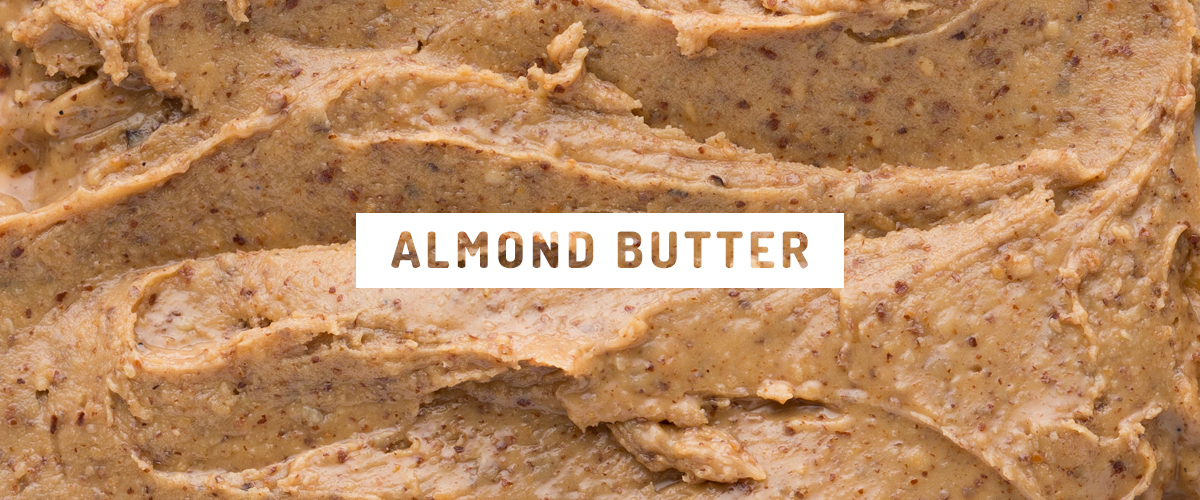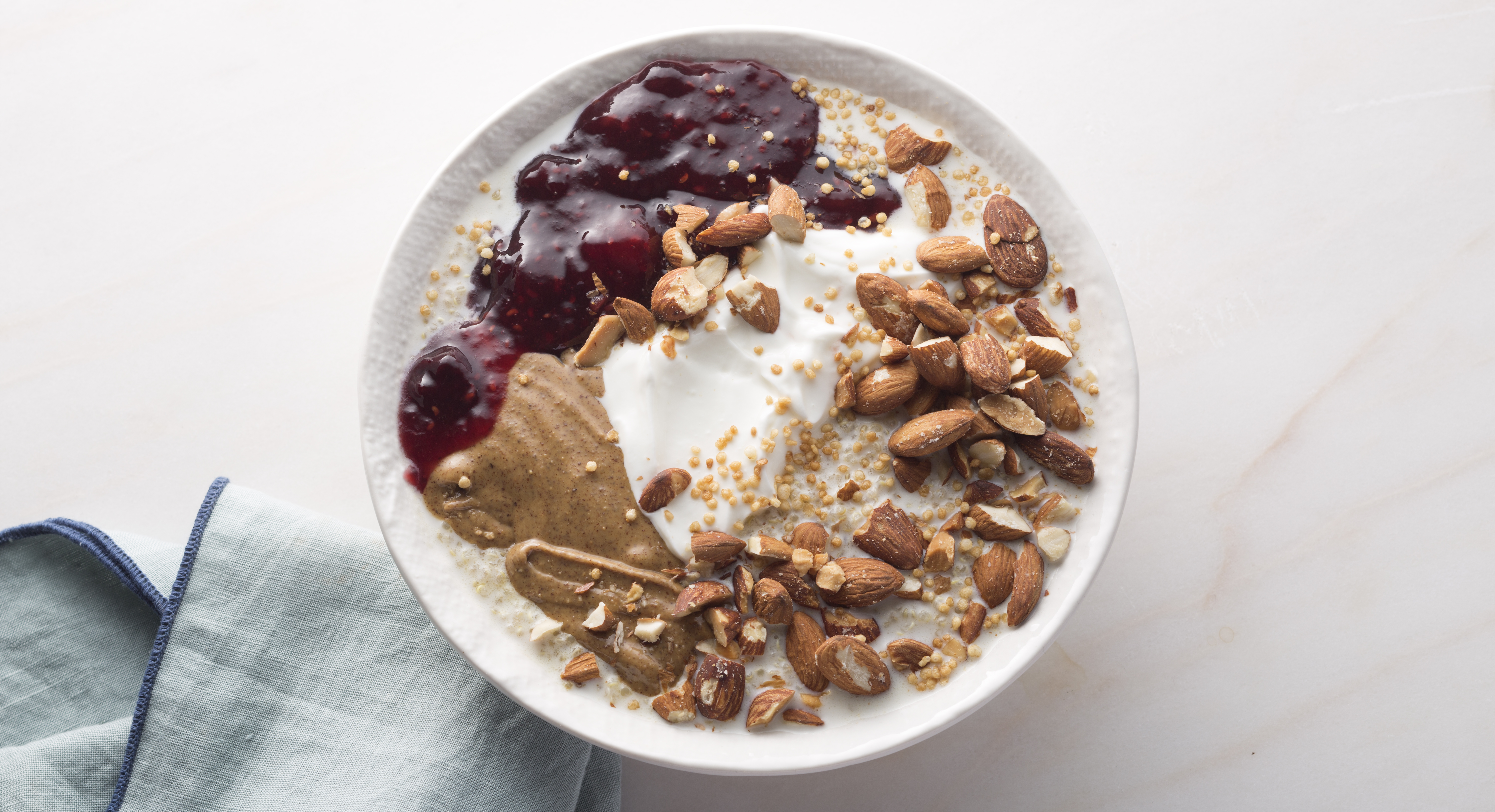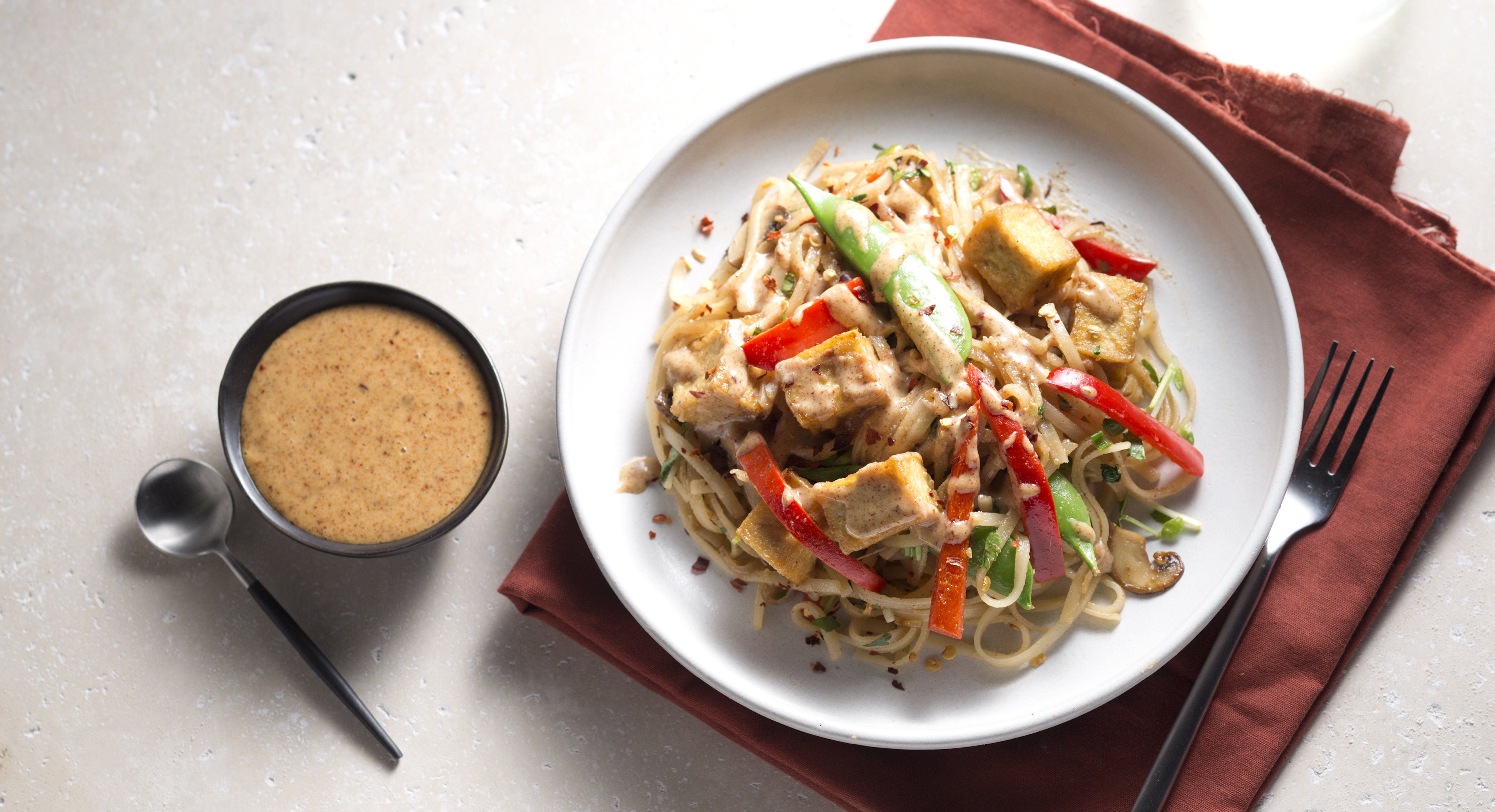Almond butter vs. peanut butter was not typically a topic of discussion in my household growing up. Neither was the difference between shea butter and cocoa butter. There was always an open jar of reduced-fat Jif in our pantry. “It’s healthier,” Mom said as she slathered two pieces of frozen whole wheat bread with the peanut butter, gave each side a heavy-handed dusting of cinnamon sugar, slapped the bread together, and dropped the sandwich into a ziplock bag for school lunch.
So when I found out that reduced-fat peanut butter wasn’t actually that good for you, I was floored. What I learned: It has tons of added sugar, is only 60 percent peanuts (what’s the other 40 percent!?), and by the way, has a mere 4 grams less fat than the regular, full fat version. It was as if someone had just come up to me and explained that the world is actually flat and my entire life is a lie. I couldn’t comprehend it.
That was years ago—I’ve since recovered. And it’s now common knowledge that a product with a “whole wheat” or “low fat” label isn’t necessarily more healthy—peanut butter included. And a whole new set of nut butters have risen to the top of grocery carts—including Thrive Market’s own line of single-ingredient nut butters! Prompting the great debate of which is better- almond butter vs. peanut butter? Our smooth and chunky varieties of almond and peanut butters have almonds and peanuts, respectively, as the only ingredients so you know exactly what you’re eating. How does almond butter (AB) measure up to PB in terms of nutritional and health benefits? Let’s take a closer look:
Macronutrients
Carbohydrates, fats, and proteins—they’re the building blocks of nutrition, and give you a general idea of how good for you that sandwich spread is. Where calories are concerned, almond defeats peanut butter, but not by much: When comparing two all-natural butters, one serving (two tablespoons) of almond butter weighs in at 190 calories, and the same amount of peanut butter clocks in at 210 calories. When comparing two all-natural butters, one serving (two tablespoons) of almond butter weighs in at 190 calories, and the same amount of peanut butter clocks in at 210 calories. When using larger amounts, it seems that the fewer calories in almond butter will win outright.
Carbohydrates
Both nut butters are relatively low in carbohydrates, but almond has slightly fewer net carbs thanks to its higher fiber content. That means that both spreads are good options for low-carb diets. However, Paleo converts will want to steer clear of peanut butter—surprisingly, peanuts aren’t nuts and actually fall under the legume category, which means that anyone sticking to a primal diet should stay far, far away.
Winner: Almond butter, because it has more fiber
Fats
The majority of calories in nuts are derived from their high fat content—but that doesn’t mean you should avoid them. Both almonds and peanuts contain monounsaturated fats (MUFAs), which have been linked to a reduced risk of heart disease. We know that MUFAs are found in a lot of healthy foods like avocados, olive oil, and nuts, but researchers are still a little foggy on how exactly they contribute to heart health. Regardless, the USDA recommends that 25 percent of our daily calories come from MUFAs.
Almond butter and peanut butter both contain around 17 grams of fat per serving, but AB has 1.5 grams of saturated fat to PB’s 2 grams.
Winner: Tie, because both contain the good fats essential for heart health
Protein
Nuts are basically little nuggets of fat and protein—meaning they’re great for keeping you full and satisfied, even when ground into creamy, spreadable form. Some might be surprised to learn that a serving of peanut butter contains 7 grams of protein, more than you’ll find in an egg.
Winner: Peanut butter, by a smidge, with 7 grams of protein per serving versus almond butter’s 6 grams.
Micronutrients
If macronutrients are the building blocks of nutrition, micronutrients are the glue that holds everything together. These are the vitamins, essential minerals, antioxidants, and good-for-you compounds that kick a food’s nutrient density up a notch.
Almonds are a health food staple for a reason—they’re really, really good for you. The brown skin is chock-full of protective antioxidants, and the flesh is packed with vitamin E, the fat-soluble antioxidant that protects cells from oxidative damage. Vitamin E has been linked to a reduced risk, and even prevention, of heart disease, cancer, and Alzheimer’s disease—and a single ounce of almonds gives you 37 percent of the daily recommended value.
Almonds are also crazy-high in magnesium (one serving contains 20 percent of the daily value), an essential mineral that helps with 300 different enzymatic processes influencing everything from metabolic function to blood sugar.
Those nutrients plus the copper, vitamin B2, and phosphorus found in almonds make them one of the healthiest nuts out there.
Yet peanuts don’t exactly slouch when it comes to micronutrients either. Because they’re technically legumes, they’re more similar to garbanzos or soybeans than they are to almonds. Peanuts have some magnesium and a little vitamin E, but also contain trace amounts of nutrients that you’ll find in other legumes like calcium, iron, phosphorus, copper, potassium, selenium, and zinc. They’re also an impressive source of folate and biotin, two B vitamins important to prenatal health.
Winner: Tie. With varying nutrients, it’s difficult to compare the two here—but if you’re avoiding legumes, go for almond butter.
Allergies
This may be a seemingly easy question to answer when choosing almond butter vs. peanut butter. Today, three times as many children deal with a peanut allergy—most often fatal—as compared to 20 years ago. Some people with an allergy to peanuts need to avoid all tree nuts, but because peanuts are technically legumes, often other varieties of “true” nuts are perfectly fine to eat. (Of course, check with your doctor before trying other nuts if you have a peanut allergy.)
Winner: Probably almond butter. Peanut allergies are much more common than almond or tree nut allergies, so we’re giving this one to AB. But of course stay away from both if you have a severe reaction to nuts.
Versatility
Our food editor Merce Muse considers both nut butters kitchen staples. But if she had to choose just one in the battle between almond butter vs. peanut butter, who would she choose? “Almond butter. It’s more versatile because it has a milder flavor.”
For Muse, the ubiquitous and easily identifiable taste of peanut butter can be distracting or overpowering for some dishes. “You immediately know, ‘Oh, there’s peanut butter in this dish,’” she says, “But if you’re using almond butter, it’s more nutty and smooth, and sort of mysterious. You can’t quite put your finger on it, but it has the same texture and cooks the same way that peanut butter does.”
Almond butter can be swapped in for peanut butter, but not so much the other way around. And home cooks who are switching from conventional PB to a natural nut butter will probably need to experiment a little. “Conventional nut butters have fillers and sugars that affect how they cook,” says Muse. When trying out a new, organic product “just be prepared for your favorite batch of peanut butter cookies to taste or look a little different—you might need to add more salt or sugar into the mix.”
Winner: Almond butter,which is more versatile in both savory and sweet dishes. In Muse we trust!
Pesticides and additives
At a regular grocery store, it can be difficult to find organic peanut butter—in fact, it can be a challenge to find it anywhere. That’s because the majority of peanut farmers use conventional farming practices (including using fungicides and other chemicals) to grow their crops. Peanuts are also plagued by aflatoxin, a fungus that naturally occurs in the type of soil the plants favor. Aflatoxin can harm humans and animals when ingested—causing everything from stomach aches and abdominal pain to coma and death—and was placed on a list of carcinogenic substances by the International Agency for Research on Cancer in 1988.
Peanuts have a soft shell that’s permeable to chemicals and toxins, which means the flesh is exposed to pesticides, mold, and fungi, too. Even organic peanuts sometimes have higher concentrations of aflatoxin because they haven’t been sprayed with an antifungal. Consumers are left wondering which is worse—the mold or the pesticides?
Conventional PB brands tend to include other additives, too. The oil in natural nut butters usually separates over time, so many brands add in binding agents to keep their product smooth and spreadable with zero “stirring” needed. And when it comes to flavored (chocolate peanut butter, anyone?) or low-fat varieties, it’s almost a guarantee that they’ll be loaded with excess sugar, other oils, and added sodium.
You might be hard-pressed to find an organic peanut butter brand without any fungi at your regular grocery store, but finding organic almond butter couldn’t be easier. Organic AB seems far more popular than its conventional counterpart—there are plenty of raw, organic, and non-GMO options available for discerning shoppers.
Because almonds have a hard exterior shell (which is usually removed before packaging), like walnuts or chestnuts, they’re protected from toxins and chemicals and far easier to grow organically.
Winner: Almond butter. It’s way easier to find an organic version, and even if you opt for conventional, you don’t need to worry as much about contamination.
How to use almond butter
Figuring out what to do with almond butter isn’t rocket science—treat it like you would your favorite peanut butter. We love folding it into smoothies for a little extra protein and healthy fat, and topping quinoa porridge with a dollop to take it from merely tasty to totally sublime. AB is perfect for making desserts that are decadent but not overly sweet. Case in point: our all-time favorite almond butter dessert recipe—almond butter cups.
Almond Butter Cups
Yield: 24 chocolates
Active Time: 20 minutes
Total Time: 4 hours
Ingredients
For the base
1 cup almond butter
1/4 cup maple syrup
1 cup coconut sugar
3 tablespoons coconut oil
1 teaspoon vanilla
For the topping
2/3 cup melted coconut oil
1/2 cup maple syrup
2 tablespoons coconut sugar
2/3 cup cacao powder
2 teaspoon vanilla extract
1/2 teaspoon sea salt
Maldon salt, for serving
Line a mini cupcake tin with paper liners.
Combine all the ingredients for the base in a mixer fitted with the paddle attachment or food processor.
Whisk together the ingredients for the chocolate topping in a medium-sized bowl. Make small teaspoon-sized balls of almond mixture and place in center of each baking cup. Pour chocolate mixture over and fill flush with top line of baking cup. Place in freezer or fridge for several hours until firm. When ready to serve, sprinkle with Maldon salt.
More almond butter recipes
You can really use almond butter at every meal—for breakfast, lunch, dinner, or dessert, it’s a healthy and balanced ingredient that adds creaminess to any dish.
Breakfast
Chocolate Pear Smoothie Banana Whole Wheat Waffles Cacao Buckwheat Pancakes Quinoa Porridge Blueberry-Ginger Smoothie
Snacks
Chocolate, Almond Butter, and Jam Cracker Sandwiches Recipe
Omega-3 Maple Almond Butter
Honey Almond Popcorn Balls
Lunch and Dinner
Raw Carrot Pad Thai
Gluten-free Spring Rolls
Dessert
Paleo Fudge
Chocolate Paleo Scotcheroos
Raw Thumbprint Cookies
Almond Butter vs. Peanut Butter Comparison
While the specifics vary from brand to brand, this handy table provides an approximate comparison of the key nutritional components between almond butter and peanut butter (per 2 tablespoon serving). [1,2].
| | Nutritional Information | Almond Butter | Peanut Butter |
| | Serving Size | 2 tablespoons | 2 tablespoons |
| | Calories | 196 | 191 |
| | Total Fat | 18g | 16g |
| | – Saturated Fat | 1.3g | 3g |
| | – Monounsaturated Fat | 10g | 8g |
| | – Polyunsaturated Fat | 4g | 4g |
| | Cholesterol | 0mg | 0mg |
| | Sodium | 2mg | 137mg |
| | Total Carbohydrates | 6g | 7g |
| | – Dietary Fiber | 3g | 2g |
| | – Sugars | 1.4g | 3g |
| | Protein | 7g | 7g |
| | Vitamin E | 7.3mg (49% DV) | 2.9mg (19% DV) |
| | Magnesium | 89mg (21% DV) | 54mg (13% DV) |
| | Phosphorus | 163mg (13% DV) | 108mg (9% DV) |
| | Niacin | 1mg (6% DV) | 4mg (25% DV) |
Almond butter or peanut butter?
Bottom line: which nut butter is best in the battle of almond butter vs. peanut butter? In terms of nutrition, both are pretty good choices—they’re nearly equal in protein, healthy fats, and calories, and have their own unique but comparable micronutrient profiles.
But for those concerned with toxins, fungi, and GMOs, organic almond butter seems to be the safer bet. Good news—you can find both organic peanut butter and almond butter at Thrive Market—and we also have non-GMO varieties, too.
Photo credit: Alicia Cho






